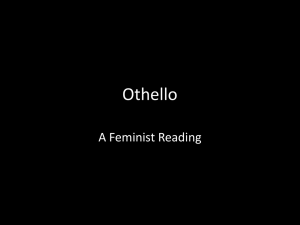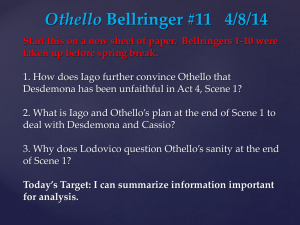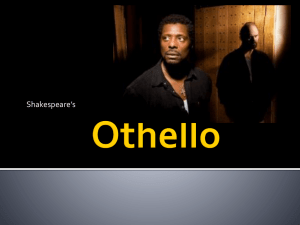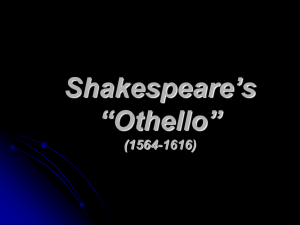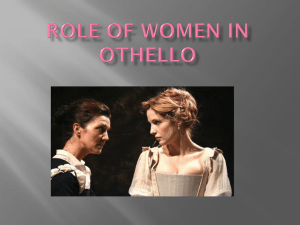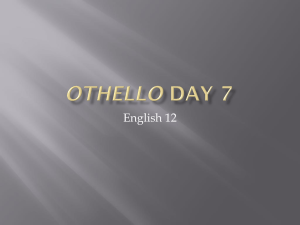Othello Present
advertisement
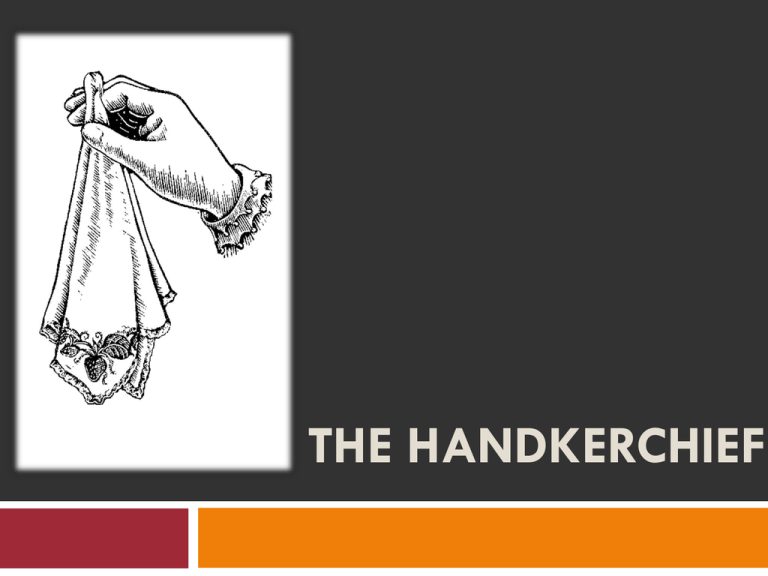
THE HANDKERCHIEF Symbol: The handkerchief Symbols are objects, characters, figures, or colors used to represent abstract ideas or concepts. A. The handkerchief is more than just a piece of square cloth, it means different things to different people in the play, and is an indicator of character, a test of relationships and a key symbol of major themes in the play. It is the pivotal to the plot. B. The most dominant symbol in the play is the handkerchief that was Othello’s first gift to Desdemona. C. Spotted with strawberries the handkerchief, is symbolic of a white wedding sheet stained with virginal blood. ( This raises the idea of whether Desdemona and Othello have consummated their marriage and questions Desdemona’s virginity that lurks beneath the surface of the play.) D. Othello warns Desdemona that the handkerchief is a sacred love token with magical powers, and to lose it is to lose his love. Iago has schemed to have it stolen away. The loss of the handkerchief convinces Othello that Desdemona is guilty of betraying him. - Othello is so upset that he is physically ill. Desdemona arrives and tries to bandage his head with the handkerchief. - Here Othello touches and sees the handkerchief, he then drops the handkerchief. - Emilia finds the handkerchief, remembering her husband Iago had asked for her to steal it earlier. Emilia plans to have it copied, and give the copied version to Iago. - Iago enters and snatches the handkerchief without telling Emilia his purpose for the handkerchief. - Iago tells us in his soliloquy , that he is going to plant the handkerchief in Cassio’s lodgings, where he is sure to find it, and hence will provide enough proof to Othello that Cassio is having an affair with Desdemona. - Othello demands proof of Desdemona’s disloyalty and Iago’s socalled ‘proof’ is the handkerchief. Act 3 Scene 4 Act 3 Scene 3 Handkerchief Timeline - Desdemona is puzzled that she can’t remember where she left the handkerchief. Emilia says she doesn’t know where it is, when in fact she does. - We know that the handkerchief is evidence in Iago’s case against Desdemona. But neither women know nothing about that. - Othello enters and demands to see the handkerchief, Desdemona responds that she doesn’t have it with her, however informs him that it is not lost. - Later in the scene Cassio gives the handkerchief to his prostitute girlfriend Bianca, she assumes it is a love token from another woman. Cassio denies this and reassures her he found it in his chambers. - Iago manipulates Othello to constantly think of the handkerchief, so that every essence of Dedemona’s adultery with Cassio has always been linked to the handkerchief. Othello links that the handkerchief is a kind of proof but not a confession. - Iago arranges for Othello to secretly overhear Iago and Cassio converse. Bianca charges in with the handkerchief proving to Othello Cassio had the handkerchief given to him by Desdemona. Act 5 Scene 2 Act 4 Scene 1 Handkerchief Timeline contd. -Finally in this scene is the last mention of the handkerchief, Othello accuses Dedemona of having an affair with Cassio, but Desdemona denies it. - Desdemona has died, and it is Emilia who has the final say on the handkerchief. She tells the Othello that it was she who found the handkerchief and gave it to her husband Iago. Everyone tells the truth. Othello’s Gift Act 3 Scene 4 • Othello enters the scene demanding to see the handkerchief, Desdemona tells him she does not have it , he tells her why it should never be lost. It was given to Othello's mother by an Egyptian who was "a charmer, and could almost read / The thoughts of people" (3.4.57-58). As long as Othello's mother kept it, she would keep the love of her husband, but that "if she lost it / Or made gift of it, my father's eye / Should hold her loathed" (3.4.60-62). When she was dying, Othello's mother gave him the handkerchief and told him to give it to his wife when he married. Therefore, Othello warns Desdemona, "To lose't or give't away were such perdition [loss, damnation] / As nothing else could match" (3.4.67-68). • He then tells her that its decorations were sewn by a two-hundred-year-old prophetess, that its silk came from blessed silk worms, and that "it was dyed in mummy which the skilful / Conserved of maidens' hearts" (3.4.74-75). "Mummy" is fluid drawn from embalmed bodies, and to "conserve" something is make a special mixture which will last a long time. • Othello tells two versions of the how the handkerchief came to be, both versions are relevant to the play, but raise question about truth, faith superstition and the power of matter over mind to lead to self-fulfilling prophecy. Othello is expressing his primitive beliefs for the first time. Othello’s Gift Details of the handkerchief • Spotted with strawberries, the handkerchief could represent blood droplets on white sheets (This raises the idea of whether Desdemona and Othello have consummated their marriage and questions Desdemona’s virginity that lurks beneath the surface of the play.), a depiction of Desdemona no longer being a virgin or the ‘fruits of love’ Othello is looking forward to on the wedding night, but which afterwards he may retain in his mind as an image of Desdemona’s impurity and loss of chastity. • Strawberries in Christian symbolism mean righteousness; they also have been used in art and literature to suggest sensuality and sexuality because of their redness and sweetness. • Suggests a guarantee of virginity as well as fidelity The handkerchief IN-DEPTH Significance of the handkerchief to Othello • It is a romantic object he gave to Desdemona and asked her to cherish, therefore to him it is a symbol of his love for her and of the faith and trust which bind their marriage; by losing it she is rejecting. • A symbol of Desdemona’s body, which he thinks she has given to someone else, it is privacy of Desdemona made public. Since she is herself valuable emblem of Othello’s success, the handkerchief is therefore the emblem of that emblem. • It is a sentimental link to Othello’s mother, a symbol of his parents marriage ‘an antique token” linking him to his childhood past, a superstitious talisman, a magic which must be respectd or something precious will be destroyed. • He associates it with beauty, intimacy, physical contact, tenderness, the female duty to sooth the male troubled brow, and these can be stolen from him and enjoyed by others, it seems the loss of the handkerchief, equals not only the los of love but the loss of Desdemona’s soul, as he sees it. • Conclusive evidence of his wife’s adultery. On the other hand, by rejecting it as “too little” he is rejecting Desdemona’s attempts to minister him and therby love; he cuases it to fall to the floor and lie unnoticed, so that ironically he is the one who separates her fro it and causes the chain of tragic events to come from it’s loss. Significance of the handkerchief to Desdemona • It is a love gift, a lucky charm to make Othello love her as his father loved his mother, and her only link to his family and his past. • She kisses it and talks to it, s a substitute for physical presence of Othello. It suggests her immaturity ( innocence, purity) that she treats is as a child treats a comfort cloth, unable to be parted from it. • Her offer to use it as a bandage to bind his head shows her sympathy and wifely duty. Significance of the handkerchief to Iago • The handkerchief in itself is a silly toy, but it is useful as the provider of the ‘ocular proof’, of Desdemona’s infidelity which Othello has demanded. It reassures him that fate is on his side, since it so conveniently materialises just when he needs it. (It questions why Iago ‘wooed’ Emilia ‘a hundred times’ if the plot against Othello is a new idea.) It reassures • It reassures him how clever an opportunist he is to think up a use for it so quickly and it enables him to go beyond proof of guilt and proceed to the next stages of sentencing and execution. THE END By Kim and Gaitri

